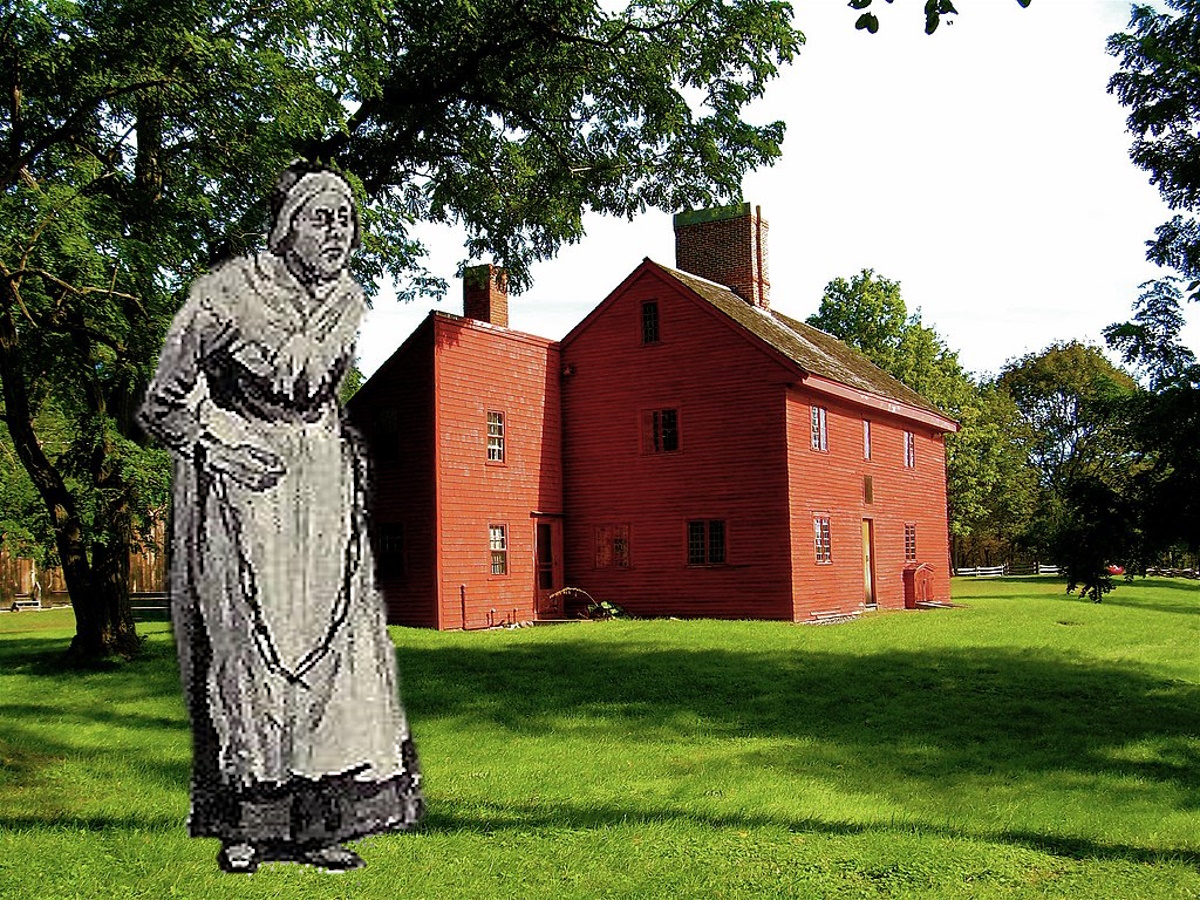Don’t be surprised if you tour the Rebecca Nurse Homestead with a descendant or relative of the innocent woman executed for the crime of witchcraft. Who knows, you might be a descendant as well!
The Story of Rebecca Nurse
Rebecca Nurse was a well-respected wife of a prosperous artisan, mother of eight and a grandmother. At 70 she was frail, possibly an invalid. People viewed her house, which sat on a 300-acre farm, as a mansion. By the standards of 1692 it probably was.
In January 1692, local girls in Salem began having fits. They started to accuse their neighbors of using black magic to torment them. Unbeknownst to Rebecca Nurse, they began to accuse her of hurting them.
One of the girls, Anne Putnam, said she saw the specter of Rebecca. Her father went to the magistrates and accused her of witchcraft. Some historians believe a property dispute lay at the bottom of the accusation.
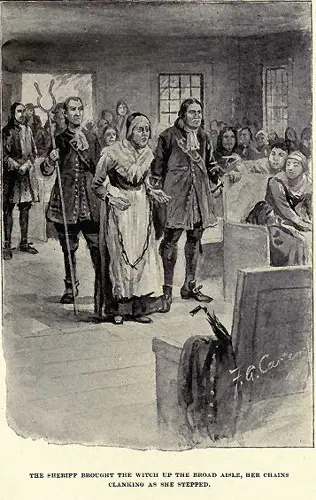
On May 24, the sheriff came to the Rebecca Nurse Homestead and arrested her for witchcraft. She supposedly said, “I am as innocent as the unborn.”
Her arrest shocked the community, which viewed Rebecca as pious and upright. Thirty nine people signed a petition in support of her.
Her trial began on June 30, 1692. The sheriff brought her in chains up the aisle of the meetinghouse. Her accusers, who included young girls who later recanted, claimed she flew in on a broomstick to a Satan-worshipping ceremony performed by the Rev. George Burroughs. Others came, whole families of witches, they said.
Trial of Rebecca Nurse
According to the testimony, Burroughs started off with a trumpet and drum roll, then preached to the hundreds assembled that they must replace God’s churches with Satan’s. At noon, Burroughs administered the scarlet sacraments with help from his deacons Rebecca Nurse, Sarah Osborn, Sarah Good and Sarah Wildes. Then they had lunch, with Burroughs sitting at the head of the table next to a man in a white hat with a high crown. The Devil promised Burroughs he would reign as King of Hell.
A jury found her not guilty.
But the girls who first accused her started having fits and crying out against her. Chief Justice William Stoughton asked the jury to reconsider. The jury then found her guilty. “I am an innocent person,” she said.
On July 19, she was hanged with four other women, probably on Proctor’s Ledge in Danvers. Her body was buried in a shallow, unmarked grave nearby.
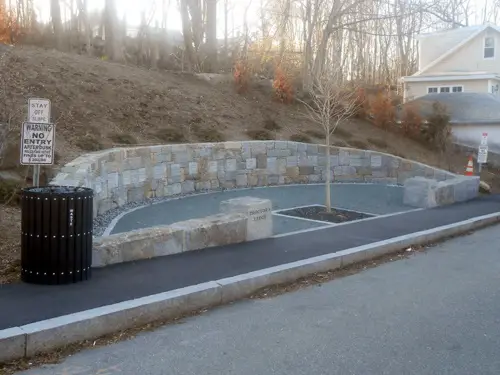
A memorial to the victims of the Salem witch trials was recently created at Proctor’s Ledge.
Rebecca Nurse Homestead
The house itself is a First Period dwelling, a colonial saltbox built around 1678. Over the years it had many additions. Her great grandson Francis Nurse later lived in the house. After the Lexington Alarm, he marched from the house to the Battle of Lexington and Concord in Capt. John Putnam’s Danvers militia. Francis married Eunice Putnam. The Putnam family bought the property in 1784 and lived in it until 1905.
By 1908, a local woman named Sarah Hunt had raised enough money to buy the Nurse Homestead. The Rebecca Nurse Memorial Association took ownership of the house to restore it and turn it into a museum. The Association eventually turned it over to the Society Preservation for New England Antiquities, which then turned it over to a group of 18th-century living history reenactors called the Danvers Alarm List Company.
Today, the public can visit four of the rooms: the great room, sleeping chamber, lean-to and parlor. All have period furnishings.
Twenty-seven acres of alfalfa fields surround the house. On them stands a house owned by Zerubbabel Endecott, the son of Gov. John Endecott. The grounds also include a reconstruction of the Salem Village meeting house at the time of the trials. Moviemakers built it for Three Sovereigns for Sarah.
The property also includes the family burial plot, where Rebecca is believed to be buried. In 1985 her descendants dedicated a granite obelisk to her memory, the first memorial to anyone accused of witchcraft in North America.
The house includes a small archeological exhibit with artifacts recovered from the property.
Danvers, Mass.
The Rebecca Nurse Homestead is not in Salem, but 15 minutes away in Danvers, which used to be Salem Village. Some will find it a welcome respite from Salem’s crowded, witch-related tourist traps, especially at Halloween. Others who enjoy crowds and spectacle, not so much.
The Rebecca Nurse Homestead is near Glen Magna Farms, a historic country estate open to visitors. If you’re in the area for maritime history, head to Salem for the Peabody-Essex Museum. If architecture floats your boat, take a stroll downChestnut Street, once called the most beautiful street in America.
For lunch, try Red’s Sandwich Shop smack in the center of Salem’s historic downtown. Reds has had its doors open since 1945. Originally the London Coffee Shop, the patriots gathered there in Revolutionary times.
Five Things You’ll Remember About the Rebecca Nurse Homestead
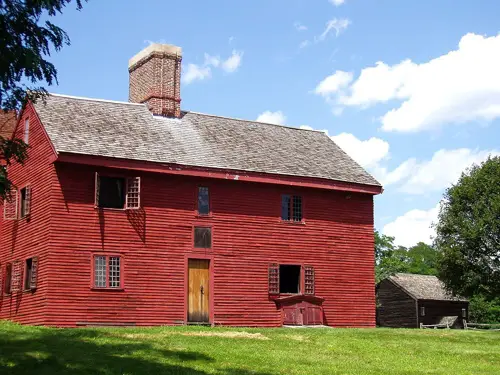
Site of her Arrest.
Inside the house, you can stand in the doorway where Rebecca probably encountered the sheriff who arrested her and took her to Salem jail.
Replica of the Salem Meeting House.
Though it’s only a replica, it has a rustic, authentic feel that may make your skin crawl. Many of the events leading to the executions of 20 innocent people — along with five who died in jail — happened in and around the meeting house.
Family cemetery.
Though it isn’t 100 percent certain that Rebecca Nurse is buried there, she probably is. According to family lore, her children secretly disinterred her from the shallow grave and reinterred her in the family plot. In 1992, the body of another victim of the witchcraft madness, George Jacobs, was moved to the Nurse family burial ground. The cemetery lies a short distance from the house.
Authentic Period Furniture.
The restored house still has an authentic feel, with period furniture and household artifacts. A spinning wheel testifies to the way Rebecca would have spent a great deal of her time. Outside, typical 17th-century crops grow in the kitchen garden.
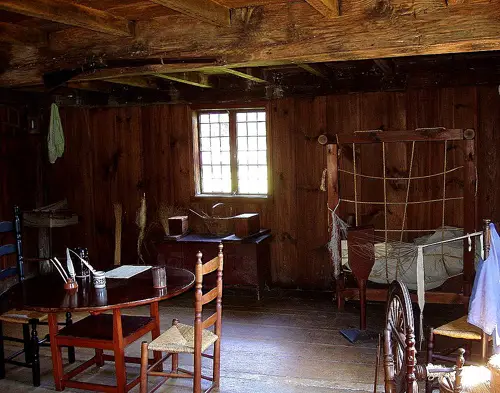
Alfalfa Fields.
Twenty seven acres of greenery surround the house in the middle of dense suburban development. You won’t see a single modern house from the vantage point of the Rebecca Nurse Homestead, which helps take you back to 1692.
If you visit…
Check the times beforehand on the website and get there early. Volunteers run the homestead, so it’s sometimes closed.
The homestead has little in the way of signage, so read up on it beforehand, watch Three Sovereigns for Sarah or take a guided tour.
There’s a gift shop, and you can park on the grass. The mobility-impaired will not find it accessible.
Website: https://www.rebeccanurse.org/visitor-information/
Images: Featured image of homestead, By Willjay at the English Wikipedia, CC BY-SA 3.0, https://commons.wikimedia.org/w/index.php?curid=82142949. Interior of homestead by David via Flickr, CC by 2.0. First floor of Rebecca Nurse House By Daderot. – Self-photographed, CC BY-SA 3.0, https://commons.wikimedia.org/w/index.php?curid=1029532. Rebecca Nurse House (front view) By Daderot. – Self-photographed, CC BY-SA 3.0, https://commons.wikimedia.org/w/index.php?curid=1029510. Proctor’s Ledge Memorial By Jangseung92 – Own work, CC BY-SA 4.0, https://commons.wikimedia.org/w/index.php?curid=95696697.
